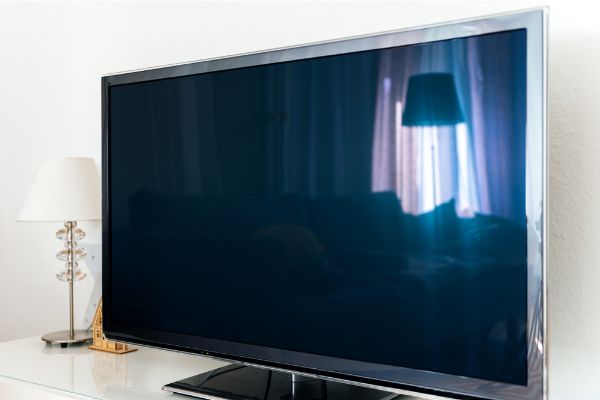Disclaimer: This post may contain affiliate links, meaning we get a small commission if you make a purchase through our links, at no cost to you. For more information, please visit our Disclaimer Page.
Television is one technology that developers have advanced almost since the inception of the first TVs of the past. Once these displays hit the market, many homes had at least one set. The original televisions were large, heavy boxes, and the actual screen display that you got for a unit of that size was comparatively small. As technology in this field moved forward, manufacturers were able to create lighter, larger, and flatter displays using different methods.
The plasma panel is one such part of this technology. Often something people in the tech world might refer to as a PDP, the plasma display became the first large, flat screen that was available to the general consumer. If a flat television was over 32 inches in size, it probably used plasma technology first.
Although plasma displays are largely obsolete today, you may find them for sale in various markets, or a tech enthusiast may have one that acts as a working model. In either case, some people may wonder why plasma televisions seem to get so hot. This is the primary topic we will address in today’s article. As we get into the subject, we’ll try to discuss the normal levels of heat for plasma TVs, too.
Additionally, we can talk about what might happen if a plasma display gets hotter than it should, what kind of ventilation a television needs for good performance, and things you might do to keep a plasma screen cool.
Table of Contents
Why Does My Plasma TV Get So Hot?
Before we get into exactly why your plasma TV might seem to get very hot, it is important to understand the technology behind displays of this type. As the name suggests, a plasma television is able to show you images and video using tiny cells of gas in an ionized state.
These cells full of gas are responsive to electrical fields, and when the fields charge those cells, they heat up. This is just one part of how a plasma television works to display the imagery you see on the screen.
The plasma cells contain a bit of mercury vapor, and the electrical current excites this vapor to the point that it will radiate as light, and the different lights will help the machine display the images. However, many of the photons that the plasma will emit also release as heat sources rather than light sources.
Because of this, the screen on a plasma television can get quite hot. This is doubly true for some of the older models of plasma TVs that you might be able to find today. Some of the early models that manufacturers produced could get hot enough that the heat output was something you could notice even when you weren’t standing next to or touching the display. Newer models improved their efficiency levels, but all of them would produce heat to some degree.
Part of the reason for this output also has to do with the energy necessary to run the device. Your typical plasma screen over 40 inches might use over 200 watts in order to make things work. That’s a lot of energy, and it is significantly more than a standard LCD screen of the same size might need to use.
All in all, a plasma screen is going to feel at least warm, and it may get hot. The primary reason for this has to do with the technology that powers the display and the energy requirements of the device itself.
Is It Normal for Plasma TVs To Get Hot?
Yes, it is normal for plasma TVs to get hot. As we touched on earlier, heating up the cells in the display is how you get the images you want to appear on the screen. In order to do that, some of the energy must release itself as light. However, an even greater portion of that energy leaves those cells as heat instead.
Because of the way developers make plasma televisions, they need high voltages and steady currents. The supporting boards that manufacturers had to install in these kinds of TVs could also be heavy. As with many things in the tech world, earlier models seemed to be less efficient than their more recent cousins.
However, all plasmas developed in ways that made running hot a part of their design. Some of the cheaper, less efficient models may have lacked fans or other cooling systems. These types of plasmas might get even warmer than others on the market, and it is possible that they would fail before their more expensive counterparts. Having said that, all models running on this type of technology should have been able to last a few years.
Further, plasma models that companies developed later would have more than one cooling fan just for a single unit. The panels would increase in efficiency over time, and the sustain boards that the TVs needed would be of better quality, offering additional cooling properties to the units. Based on the technology these devices used, no plasma would ever be cool to the touch.
What Happens When a Plasma TV Gets Too Hot?
It is true that plasma televisions are supposed to get warm, and they may even seem hot when you touch them. However, it is worth discussing if there is ever a point at which a system like this can get too hot. Although that is not likely, what happens to your plasma TV if it gets too hot may depend on how long you leave it on continuously. Since these are systems that get hot by nature, it can be difficult for the average user to determine what might be happening inside.
In most cases, you would just shorten the overall life of your plasma television slowly. This wouldn’t be something you could notice or track immediately, but it would start to have an impact on the components inside. The hardware inside a plasma display includes parts that are supposed to take a certain amount of strain.
The developer would give a tentative rating for hours of life for the television while it is under this strain.
Should overheating problems occur regularly, you may shorten the number of usable hours for your plasma screen or you’ll find your plasma tv shut off randomly while it’s too hot.
How Do I Reduce the Heat on My Plasma TV? (5 Ways To Cool It Down)
Keeping your plasma display as cool as it can be might be a way to extend its life. If nothing else, it can certainly help to take some of the strain off the components that are either producing heat or in contact with it. Here are a few of the things you can do that may reduce the heat that your TV has to manage:
- Give the unit enough space to breathe easily. We’ll go over more on this later, but a plasma TV needs a lot of space in order to be able to vent its heat out into a cooler room.
- Keep the plasma display dry. You may wish to avoid drinking beverages near the TV. Any kinds of liquids, spills, condensation, or changes in humidity in the air can cause the components to corrode early. Keep the display dry, and consider keeping it in a climate-controlled room as much as possible.
- Lowering the brightness might also lower some of the unit’s heat output. It should certainly reduce the glowing phosphor trails that plasmas make sometimes.
- Although a plasma TV should have fans in it, you may wish to place it near external fans that can act as additional cooling devices.
- Consider keeping your plasma TV plugged into a surge protector. This device can help you make sure that the television has some protection against voltage spikes if it goes out and comes back on during a storm. Such a spike could fry components, or it might cause them to overheat and lose some efficiency.
How Much Ventilation Does a TV Need?
Different kinds of televisions may have various requirements for ventilation. Some sets have panels that you can attach flush to a wall, for example.
However, plasma TVs tend to be bulkier, and they may need more ventilation than any of the technologies present in their cousins. Most plasma designs should have several fans that vent hot air out after it has blown over the internal components.
It is a good idea to make sure that no surfaces in the home block any vents that the set might need to use. The fans on many plasma models sit in the back, so it is probably best not to put your plasma display against anything that could impede these cooling units. If possible, make sure all sides of the display are open and unobstructed.
Conclusion
Plasma televisions can still make good displays today, and this might be particularly true if you can get an inexpensive one that is still in good working order. They do run hotter than other display technologies, and you need to take a bit of extra care with them.
Manufacturers designed these units to get hot and stay that way, but you can take care of yours by giving it plenty of space for ventilation and keeping it safe from excess condensation or humidity. If you think your plasma display is getting too hot, you can try out some of our troubleshooting tips above.


